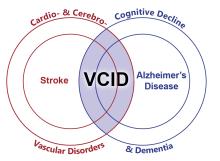
The science of VCID overlaps between blood vessel disorders, including stroke, and cognitive decline and dementia, including Alzheimer’s disease. Image courtesy Roderick Corriveau, Ph.D., NINDS
MarkVCID brings team science approach to small vessel disease biomarkers in the brain
To better predict, study, and diagnose small vessel disease in the brain and its role in vascular contributions to cognitive impairment and dementia (VCID), the National Institutes of Health has launched MarkVCID, a consortium designed to accelerate the development of new and existing biomarkers for small vessel VCID.
The five-year program, developed by the NIH’s National Institute of Neurological Disorders and Stroke (NINDS), in collaboration with the National Institute on Aging (NIA), consists of seven research groups across the United States working together via a coordinating center based at Massachusetts General Hospital, Boston. A kick-off meeting for the consortium was held immediately prior to the International Stroke Conference 2017 in Houston, Feb. 20-21.
Steven M. Greenberg, M.D., Ph.D., director of the Hemorrhagic Stroke Research Program at Massachusetts General Hospital will serve as the project leader for the MarkVCID Coordinating Center.
“We have brought together a number of outstanding research groups to further develop and validate candidate biomarkers for cerebral small vessel disease,” said Dr. Greenberg. “This will be achieved by identifying and focusing on the most promising biomarkers across the research sites.”
VCID impacts millions of people in the United States, as a part of clinical Alzheimer’s disease and in other diagnoses. Because small vessel VCID progresses over time, it is a prime candidate for treatment. However, the changes that occur are highly difficult to detect, in particular at early stages of the disease when intervention might be most successful.
Currently, individual groups are using several noninvasive biomarker candidates based on MRI scans, fluid analysis, or other physiological measurements. However, it is necessary that they be standardized and validated before they can be applied to clinical trials and eventually everyday settings. The purpose of the consortium is to take candidate biomarkers through these next steps.
“The team-based approach taken by the consortium allows us to study candidate biomarkers across different clinical settings at multiple institutions,” said Roderick Corriveau, Ph.D., program director, NINDS. “Ultimately, we hope to develop a gold standard to identify cerebral small vessel disease early enough to intervene with treatment.”
The second phase of the project, which is expected to begin in about two years and involve the dissemination of those candidates showing the greatest potential to all consortium sites. The goal is to deliver small vessel VCID biomarkers that are ready for phase II and phase III clinical trials.
Dr. Greenberg will receive the William M. Feinberg Award for Excellence in Clinical Stroke at the International Stroke Conference on Feb. 24, and his presentation will include remarks about this consortium.
- by Carl P. Wonders, Ph.D.
Projects supported by markVCID include:
VCID biomarkers coordinating center
Steven M. Greenberg, M.D., Ph.D.
Massachusetts General Hospital, Boston
Development of MRI microvascular biomarkers in cognitive impairment and dementia
Hanzhang Lu, Ph.D.
Johns Hopkins University, Baltimore
Marilyn S. Albert, Ph.D.
Johns Hopkins University, Baltimore
Imaging cerebral and retinal microvasculature in cerebral small vessel disease
Danny J. J. Wang, Ph.D.
University of Southern California, Los Angeles
Amir H. Kashani, M.D.
University of Southern California, Los Angeles
John M. Ringman, M.D.
University of Southern California, Los Angeles
Microglial, inflammatory, and omics markers of cerebral small vessel disease in the charge consortium
Sudha Seshadri, M.D.
Boston University Medical Campus
Myriam Fornage, Ph.D.
University of Texas Health Science Center, Houston
Russell P. Tracy, Ph.D.
University of Vermont, Burlington
MRI and CSF biomarkers of white matter injury in VCID
Gary Allen Rosenberg, M.D.
University of New Mexico Health Sciences Center, Albuquerque
Multimodal MRI biomarkers of small vessel disease for older persons with and without dementia
Julie A. Schneider, M.D.
Rush University Medical Center, Chicago
Konstantinos Arfanakis, Ph.D.
Illinois Institute of Technology, Chicago
Novel imaging and endothelial biomarkers of small vessel cerebrovascular disease
Joel H. Kramer, Psy.D.
University of California, San Francisco
Charles S. DeCarli, M.D.
UC Davis Health, Sacramento, Calif.
Small vessel disease biomarkers in a longitudinally-followed “stroke belt” cohort
Donna M. Wilcock, Ph.D.
University of Kentucky, Lexington
Gregory A. Jicha, M.D., Ph.D.
University of Kentucky, Lexington
For more information:
National Institute of Neurological Disorders and Stroke
National Institute on Aging
###
The NINDS (http://www.ninds.nih.gov) is the nation’s leading funder of research on the brain and nervous system. The mission of NINDS is to seek fundamental knowledge about the brain and nervous system and to use that knowledge to reduce the burden of neurological disease.
About the National Institute on Aging: The NIA leads the federal government effort conducting and supporting research on aging and the health and well-being of older people. It provides information on age-related cognitive change and neurodegenerative disease specifically at its Alzheimer's Disease Education and Referral (ADEAR) Center at www.nia.nih.gov/alzheimers.
About the National Institutes of Health (NIH): NIH, the nation's medical research agency, includes 27 Institutes and Centers and is a component of the U.S. Department of Health and Human Services. NIH is the primary federal agency conducting and supporting basic, clinical, and translational medical research, and is investigating the causes, treatments, and cures for both common and rare diseases. For more information about NIH and its programs, visit http://www.nih.gov.
